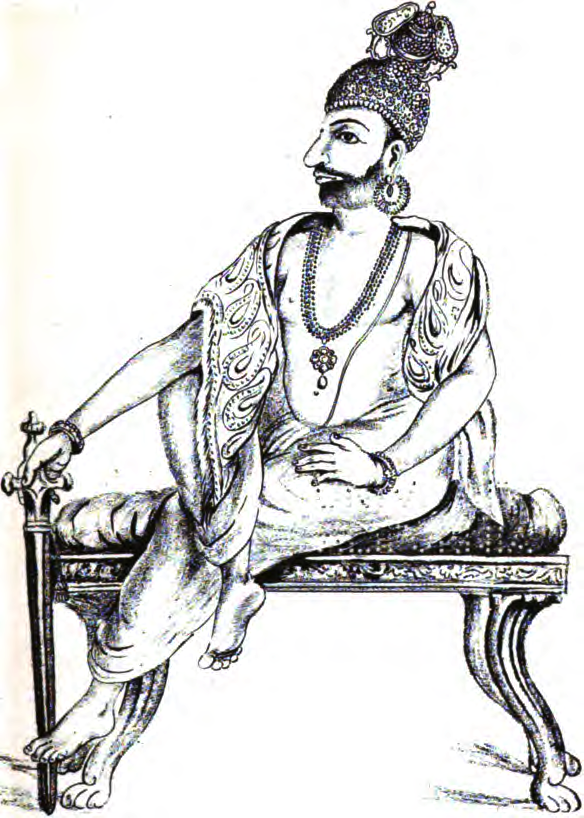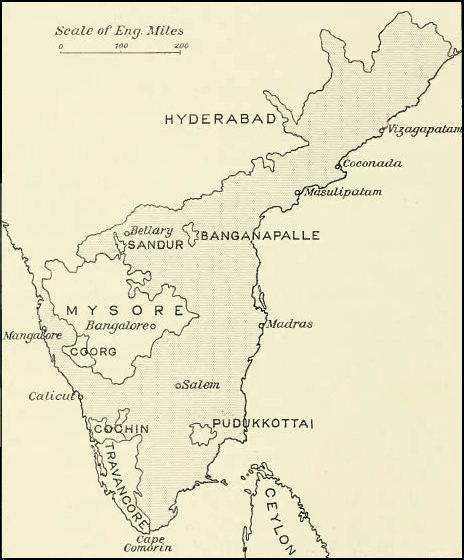|
Ayilyam Thirunal
Sir Sri Ayilyam Thirunal Rama Varma IV (1832–1880) reigned as Maharaja of Travancore from 1860 to 1880. His reign was highly successful, with Travancore, gaining the appellation of "model state of India", with such celebrated administrators as Raja Sir T. Madhava Rao and Sir A. Seshayya Sastri serving him as Diwans. Ayilyam Thirunal was the nephew of his predecessors Uthram Thirunal and Swathi Thirunal, and the grandson of Maharani-Regent Gowri Lakshmi Bayi; he was succeeded by his brother, Visakham Thirunal. Early life Ayilyam Thirunal was born on 14 March 1832 to Rani Rukmini Bayi, the only sister of Maharajahs Swathi Thirunal and Uthram Thirunal. In the Travancore Royal Family inheritance and primogeniture was determined by the Marumakkathayam system i.e. through the female line. With the accession of Uthram Thirunal in 1846 and his elder brother's exclusion from the line of succession due to imbecility, Ayilyam Thirunal became the Elaya Rajah or heir appa ... [...More Info...] [...Related Items...] OR: [Wikipedia] [Google] [Baidu] |
Maharaja Of Travancore
The Maharaja of Travancore was the principal title of the ruler of the Kingdom of Travancore in the southern part of Kerala, India. The Maharaja of Travancore was the topmost ruler of Travancore until 1949, when Travancore was acceded to India. Since then, the Maharaja of Travancore has remained in a titular position. Maharajas and Maharanis of the Kingdom of Travancore Maharanis of the Kingdom of Travancore (Aatingal Rani ) The rani of Attingal was the head of her principality and the eldest woman of the Trippapur svarupam. That meaning was specifically applied to the ranis of Attingal, in other parts of India this word had another definition. Because Travancore knew a marumakkathayam or matrilinear form of succession, the rani of Attingal had a special position. This meant that the eldest son of the rani was the first successor to Travancore's throne. His brothers and sisters were seated on the thrones of the other principalities. Therefore, the rani of Attingal could be ... [...More Info...] [...Related Items...] OR: [Wikipedia] [Google] [Baidu] |
Dewan
''Dewan'' (also known as ''diwan'', sometimes spelled ''devan'' or ''divan'') designated a powerful government official, minister, or ruler. A ''dewan'' was the head of a state institution of the same name (see Divan). Diwans belonged to the elite families in the history of Mughal and post-Mughal India and held high posts within the government. Etymology The word is Persian in origin and was loaned into Arabic. The original meaning was "bundle (of written sheets)", hence "book", especially "book of accounts," and hence "office of accounts," "custom house," "council chamber". The meaning of the word, ''Divan (furniture), divan'' "long, cushioned seat" is due to such seats having been found along the walls in Middle Eastern council chambers. It is a common surname among Sikhs in Punjab. Council The word first appears under the Caliphate of Omar, Omar I (A.D. 634–644). As the Caliphate state became more complicated, the term was extended over all the government bureaus. The ... [...More Info...] [...Related Items...] OR: [Wikipedia] [Google] [Baidu] |
Sanskrit
Sanskrit (; stem form ; nominal singular , ,) is a classical language belonging to the Indo-Aryan languages, Indo-Aryan branch of the Indo-European languages. It arose in northwest South Asia after its predecessor languages had Trans-cultural diffusion, diffused there from the northwest in the late Bronze Age#South Asia, Bronze Age. Sanskrit is the sacred language of Hinduism, the language of classical Hindu philosophy, and of historical texts of Buddhism and Jainism. It was a lingua franca, link language in ancient and medieval South Asia, and upon transmission of Hindu and Buddhist culture to Southeast Asia, East Asia and Central Asia in the early medieval era, it became a language of religion and high culture, and of the political elites in some of these regions. As a result, Sanskrit had a lasting effect on the languages of South Asia, Southeast Asia and East Asia, especially in their formal and learned vocabularies. Sanskrit generally connotes several Indo-Aryan languages# ... [...More Info...] [...Related Items...] OR: [Wikipedia] [Google] [Baidu] |
Nagercoil
Nagercoil, natively spelt as Nāgarkovil (, "Temple of the Nāgas", or Nagaraja-Temple), is a Municipal Corporation city and the administrative headquarters of Kanyakumari District in Tamil Nadu state, India. Situated close to the tip of the Indian peninsula, it lies on an undulating terrain between the Western Ghats and the Arabian Sea. Nagercoil is a centre for a range of economic activities in the small but densely-populated Kanyakumari District. Economic activities in and around the city include tourism, wind energy, IT services, marine fish production and exports, rubber and cloves plantations, agro-crops, floral production, manufacture of fishnets, rubber products among other activities. 'Nagercoil Cloves' is a distinct quality of dried cloves in the spices market, noted for its aroma and medicinal value. Cloves, pepper and other spices are grown in estates in the Western Ghats, outside the town. Nagercoil is also the nearest city to the ISRO Propulsion Comple ... [...More Info...] [...Related Items...] OR: [Wikipedia] [Google] [Baidu] |
Raja Ravi Varma
Raja Ravi Varma () (29 April 1848 – 2 October 1906) was an Indian painter and artist. His works are one of the best examples of the fusion of European academic art with a purely Indian sensibility and iconography. Especially, he was notable for making affordable Lithography, lithographs of his paintings available to the public, which greatly enhanced his reach and influence as a painter and public figure. His lithographs increased the involvement of common people with fine arts and defined artistic tastes among the common people. Furthermore, his religious depictions of Hindu deities and works from Indian epic poetry and Puranas have received profound acclaim. He was part of the royal family of erstwhile Parappanad, Malappuram district. Raja Ravi Varma was closely related to the royal family of Travancore of present-day Kerala state in India. Later in his life, two of his granddaughters were adopted into the royal family. Personal life Raja Ravi Varma was born M. R. Ry. Rav ... [...More Info...] [...Related Items...] OR: [Wikipedia] [Google] [Baidu] |
Kingdom Of Cochin
The kingdom of Cochin or the Cochin State, named after its capital in the city of Kochi (Cochin), was a kingdom in the central part of present-day Kerala state. It originated in the early part of the 12th century and continued to rule until its accession to the Dominion of India in 1949. The kingdom of Cochin, originally known as Perumpadappu Swarupam, was under the rule of the Kulasekhara dynasty (Second Cheras), Later Cheras in the Medieval India, Middle Ages. After the fall of the Kulasekhara dynasty (Second Cheras), Mahodayapuram Cheras in the 12th century, along with numerous other provinces Perumpadappu Swarupam became a free political entity. However, it was only after the arrival of Portuguese on the Malabar Coast that the Perumpadappu Swarupam acquires any political importance. Perumpadappu rulers had family relationships with the Nambudiri rulers of Edappally. After the transfer of Kochi and Vypin from the Edappally rulers to the Perumpadappu rulers, the latter came ... [...More Info...] [...Related Items...] OR: [Wikipedia] [Google] [Baidu] |
Thrissur
Thrissur (, ), Renaming of cities in India, formerly Trichur, also known by its historical name Thrissivaperur, is a city and the headquarters of the Thrissur district in Kerala, India. It is the List of most populous urban agglomerations in Kerala, third largest urban agglomeration in Kerala after Kochi and Kozhikode, and the List of million-plus urban agglomerations in India, 21st largest in India. Thrissur is classified as a Classification_of_Indian_cities, Tier-2 city by the Government of India. The city is built around a hillock called Thekkinkadu Maidan, Thekkinkadu Maidanam (തേക്കിൻകാട് മൈതാനം) which seats the Vadakkunnathan Temple, Vadakkumnathan (വടക്കുംനാഥൻ) temple. It is located north-west of the state's capital city, Thiruvananthapuram, Thiruvananthapuram(തിരുവനന്തപുരം). Thrissur was once the capital of the Kingdom of Cochin, Kingdom of Cochin (കൊച്ചി രാജ്യം - k ... [...More Info...] [...Related Items...] OR: [Wikipedia] [Google] [Baidu] |
Jenmi
Jenmi or Janmi (), plural Jenmimar, is the Malayalam term used to refer to the landed aristocracy of Kerala who traditionally held their lands as absolute and allodial owners, with such lands known as Jenmom or Janmam. They formed the landowning nobility as well as the landed gentry of the region in colonial times, and the majority of the estates and feudal properties were owned by this community. They predominantly belonged to the Nair (Warrior caste) and Nambudiri (Brahmin priest) castes. History The twenty-two families paying 3,000 rupees or more in land revenue to the Crown held 620,012 acres among them; the Vengayil dynasty alone accounted for 200,000 acres, followed immediately by the Mannarghat and Kavalappara Moopil Nairs, whose respective swaroopams governed 180,000 acres and 155,358 acres. The Zamorins of Calicut owned between 60,000 and 90,000 acres of Jenmom estate lands, followed by the Raja of Kollengode with 82,000 acres of forest and 18,000 acres of farmland ... [...More Info...] [...Related Items...] OR: [Wikipedia] [Google] [Baidu] |
Madhava Rao
Mādhava means Krishna. It may also refer to: *a Sanskrit patronymic, "descendant of Madhu (a man of the Yadu tribe)". ** especially of Krishna, see Madhava (Vishnu) *** an icon of Krishna ** Madhava of Sangamagrama, fourteenth-century Indian mathematician ** Madhvacharya, philosopher in the Vaishnavism tradition ** Madhava Vidyaranya, Advaita saint and brother of Sayana ** Venkata Madhava, 10th to 12th century commentator of the Rigveda ** Madhavdeva, 16th-century proponent of Ekasarana dharma, neo-Vaishnavism of Assam *relating to springtime; the first month of spring, see Chaitra *Madhava or Madhava-kara, an Indian physician of the 7th or early 8th century *Madhava, titular protagonist of the ancient Indian drama Mālatīmādhava by Bhavabhuti *Madhava, a character in the 11th-century Indian story collection ''Shringara-manjari-katha'' See also * * * Madhavan (other) * Madhavi (other) * Madhab (other) * Madhavaram (other) * ''Madhav'' (fil ... [...More Info...] [...Related Items...] OR: [Wikipedia] [Google] [Baidu] |
Musnud
A throne is the seat of state of a potentate or dignitary, especially the seat occupied by a sovereign (or viceroy) on state occasions; or the seat occupied by a pope or bishop on ceremonial occasions. "Throne" in an abstract sense can also refer to the monarchy itself, an instance of metonymy, and is also used in many expressions such as " the power behind the throne". A throne is a symbol of divine and secular rule and the establishment of a throne as a defining sign of the claim to power and authority. It can be with a high backrest and feature heraldic animals or other decorations as adornment and as a sign of power and strength. A throne can be placed underneath a canopy or baldachin. The throne can stand on steps or a dais and is thus always elevated. The expression "ascend (mount) the throne" takes its meaning from the steps leading up to the dais or platform, on which the throne is placed, being formerly comprised in the word's significance. Coats of arms or insignia can ... [...More Info...] [...Related Items...] OR: [Wikipedia] [Google] [Baidu] |






